|


The
Christmas Tradition
By Hans
Kopp
hans_kopp@hotmail.com

Christmas at Home
The
custom of Christmas at home is much older than “Silent Night, Holy
Night”. The Germanic cultures of early years celebrated two large
festivals, one in June when the days shortened and one in December
when the sun grew longer. The latter was replaced by the Christians
and became Christmas. The exact time this took place no one really
knows, but it was conceivable as early as the 5th century.
Do
you believe in Santa? I do. Saint Nikolaus is no myth! He was a rich
man who gave away his fortune to the poor and who made it his purpose
in life to collect food and toys for the poor children and distributed
them during the time of Christmas. In his honor most of the German
speaking nations, especially in the
Alps, celebrate December 6th ,his patron “Saint Day”, in
memory of his good deeds.
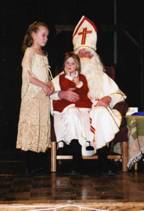
The
“Christmas Holiday season begins in the German nations on “St.
Nikolaus Day” December 6th. On this day St. Nikolaus with
his helper “Knecht Rupprecht”, also known as “Krampus” in some
parts, arrives with a load of goodies and toys.
Before he
enters the house he sends “Krampus” ahead and often scares the
small children with his mean appearance. He carries a long chain, a
big sack and a whip with which he spanks the bad children, chains them
and sticks them in his big bag.
The
children usually hide behind their mothers, while their father
wrestles
with this mean looking fellow and telling him; “all the children in
this house are good and throws him out of the house”. After that St.
Nikolaus enters the house. But, before he opens his bag with the
presents, the children sing a song for him and recite a poem to thank
him for what he is about to give them. Among all the toys he gives
each one is an “Advent Calendar”.
An Advent Calendar is a cardboard box-like frame with beautiful
Christmas pictures with dates from December 6th to December
24th . When you open the pop-out spaces of the dates, out
come a pieces of chocolate. Now the children’s “big eyed”
anticipation of Christmas Day begins.
On
Christmas Day December 24th ,early in the morning, the father
of the children goes into the forest to cut the beautiful tree he had
his eye on for a long time and takes it home. The mother takes the
children to the grandparents or to the Godparents. Then she goes home
where the father has already mounted the tree on the fixture and they decorate the tree together with nicely wrapped candies and nuts,
figs and candles. Then they hide the beautifully decorated tree. Mother cooks a
wonderful supper and father goes to get the children. After the
meal the children can hardly wait until the “Kristkindel” (Christ
Child) arrives. “Kris Cringle” has its origin from the German
“Kristkindel”.
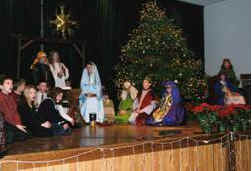 As
it gets dark outside one can hear gentle bells ringing from a
distance. As the ringing becomes louder the children are now on
pins and needles, anxiously waiting. The door opens and, as the
“Kristkindel” enters dressed in a white gown, the children
first kneel down to pray and then stand up to admire the beautiful
tree. This is followed by singing the Christmas song “Stille Nacht Heilige
Nacht” (Silent Night Holy Night). The gifts are also brought by the
“Kristkindel”, among them are apples, oranges, nuts and a toy or two.
The children sing several other Christmas songs together with their
parents in front of the tree while the “Kristkindel” moves on to
bring a tree and gifts to other children. As
it gets dark outside one can hear gentle bells ringing from a
distance. As the ringing becomes louder the children are now on
pins and needles, anxiously waiting. The door opens and, as the
“Kristkindel” enters dressed in a white gown, the children
first kneel down to pray and then stand up to admire the beautiful
tree. This is followed by singing the Christmas song “Stille Nacht Heilige
Nacht” (Silent Night Holy Night). The gifts are also brought by the
“Kristkindel”, among them are apples, oranges, nuts and a toy or two.
The children sing several other Christmas songs together with their
parents in front of the tree while the “Kristkindel” moves on to
bring a tree and gifts to other children.
Now
that the “Kristkindel is gone the children open their
presents. They
now are allowed to take a candy from the tree and eat an orange or an
apple. Time passes and it is time to go to the “Midnight Mass” in
the center of the town. On a clear night one can see the snow-covered
hills lighted up by the sparkling light of the stars.
The
holidays are not gone quite yet. There is New Year during which time
the children go out and visit their uncles and aunts and neighbors’
and wish them a happy New Year with the words; “Viel Glück im Neuen
Jahr; Gesundheit, Friede, und Einigkeit” (a lot of luck for the new
year; health, peace, and unity). In return for their best wishes they are always
rewarded with money among other goodies’. The final
Holiday
of the Christmas season is the “Holy Three Kings Day” on January 6th
, held in honor of the kings Kasper, Melchior and Balthazar. In the Alps
on this day it is customary for the children dress up as the “Holy
Three Kings” and in the early afternoon they go from house to house
to sing a song in front for the people, This is much like we do on Halloween
here in the USA but we only say trick or treat. The woman of the house
rewards the “Sternsinger” (star singers) with German daunts
cookies and candies in appreciation for their singing.
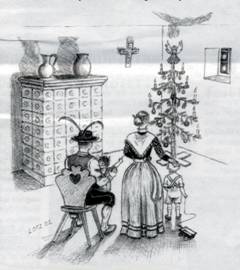 How
the Song “Silent Night” Originated How
the Song “Silent Night” Originated
It
was a few days before Christmas in the year 1818 when the organ of the
little church in Oberndorf near Salzburg
broke and Pastor Joseph Mohr was afraid not to have any music at the
“Christmas Eve Mass”. On his long way home from a sick call on the
nearby hill during the fortnight of Christmas, pastor Mohr walked
through the snow in this silent and holy night. The words came upon
him like the snowflakes from the sky. As soon as Joseph Mohr reached
home, he quickly wrote down the words and rushed over to the school's
principal's house. His name was Xaver Gruber. The pastor asked him to write a melody
to the words he just wrote. Gruber set down and shortly afterwards brought
the finished melody to pastor Mohr on Christmas Eve.
And
so, for the first time on December 25, 1818, the song was presented to
the congregation in this little church in Oberndorf. Gruber played the
melody on his guitar and also sang the base voice while Mohr sang
tenor. The church choir which had hardly time to rehearse the song
repeated the refrain to each of the tree verses. This saved a
“Christmas Eve” in Oberndorf from not having any music on that
“Silent and Holy Night”.
The
song was never sung afterwards in the church, until six years later when it
was discovered by the organ builder, Karl Mauracher in Oberndorf,
while installing a new organ in the church. The Strasser Sisters, a
singing group, who made their home also in the Zillertal valley, near
Innsbruck, Austria, were always on the search of new songs, When they
arrived in Salzburg to give a concert there. They presented the song,
which the Organ builder had found and brought it to their attention. The
Sisters loved to sing this song and it became a main stay in their
program.
The
sisters also toured Leipzig, where they presented the song. Two years later it was sold in print
in Leipzig,
for the first time, under the title “Achtes Tirolerlied” (The eighth
Tyrolian Song). The composer and writer of the song were not even
mentioned. During that time it was still far away from becoming the
most famous German-Austrian Christmas song, but the Strasser Sisters
would now sing it on every one of their tours in
Austria
and Germany
.
The
song came to prominence in the middle of the 19th. Century.
It would be heard around the German speaking towns of
Salzburg,
Innsbruck, Vienna
and in cities like
Dresden,
Leipzig,
Berlin,
Cologne
and Munich. By 1860 it was included in many German songbooks. “Stille Nacht,
heilige Nacht” is now part of every small and large Christmas
celebration, played and sung in large cathedrals, small chapels or
just at small family gathering.
Originally
the song was only known to the German speaking peoples but was later
translated into many foreign languages. It is now
sung in French, Spanish, Italian, and English, and in just about every place
where Christmas is celebrated. Now it has conquered world and is sung
around the globe.
Silent
Night Holy Night Chapel in Oberndorf
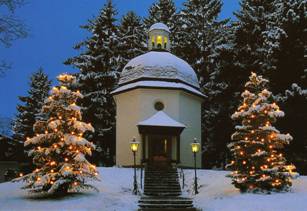 Still only few people know about its origin. At the world's Fair of 1873
the song was found in a songbook in the American pavilion named
"Carols of Salzburg". Since the origin of the song was not
known to many, a search began for the authors of the song. The son of
the composer Franz Xaver Gruber was able to prove the authorship
through the original handwriting of his father. Even then, some still
questioned the authenticity of this simple melody with the all
inspiring words at Christmas. Still only few people know about its origin. At the world's Fair of 1873
the song was found in a songbook in the American pavilion named
"Carols of Salzburg". Since the origin of the song was not
known to many, a search began for the authors of the song. The son of
the composer Franz Xaver Gruber was able to prove the authorship
through the original handwriting of his father. Even then, some still
questioned the authenticity of this simple melody with the all
inspiring words at Christmas.
The
church (Saint Nickolaus Kirche) in Oberndorf, where the song was heard
for the first time, was razed by fire in the early part of the 20th
Century. Due to the severe structural damage it was demolished. In
1937 the Gruber-Mohr Memorial chapel was built and dedicated to these two
simple and religious men on the location where the original church
stood. They contributed to the world the most beautiful
Christmas song.

|
“Weihnachtsstube” |
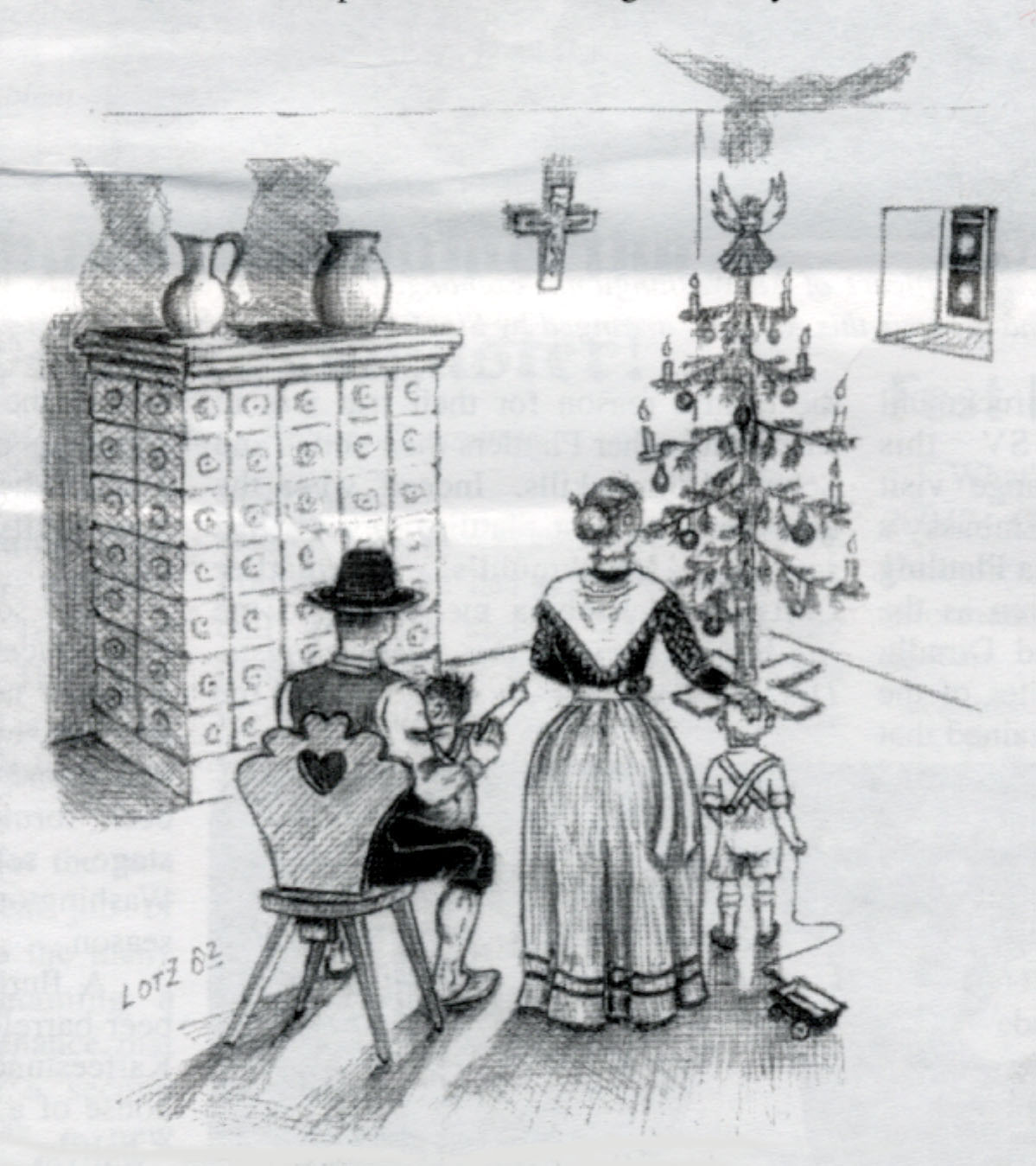
|
At
Home on Christmas Eve by Lotz. |
|
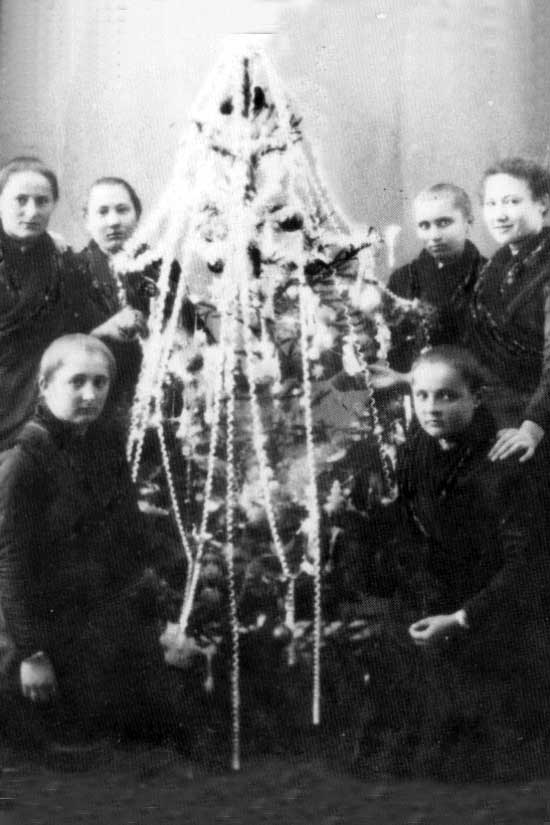 |
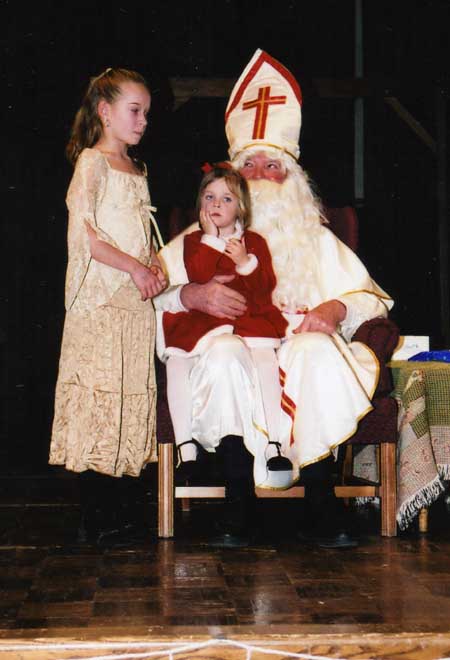 |
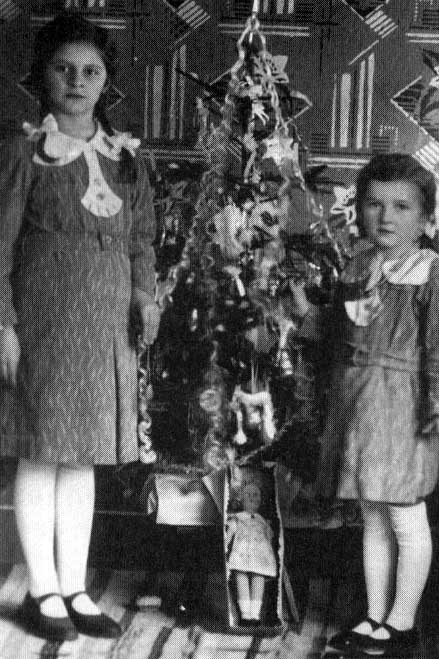 |
|
Christmas
in Batschsentiwan |
Der Heilige Nikolaus beschert die Kinder. Christmas with St.Nikolaus
is one of the many traditions celebrated during
the Christmas holiday throughout the United States
among the Donauschwaben. |
Christmas
in Setschan |
|
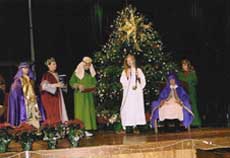 |
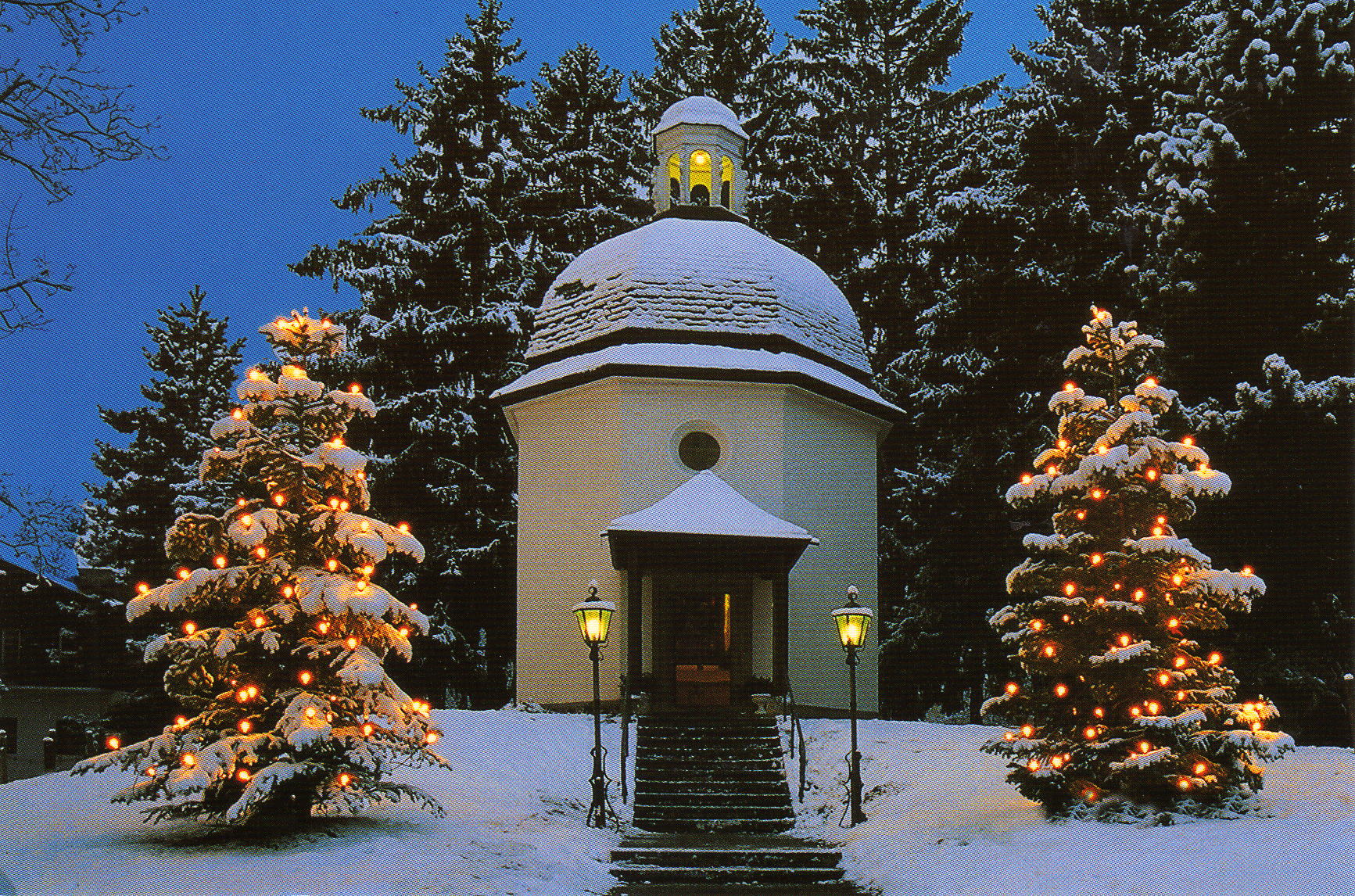 |
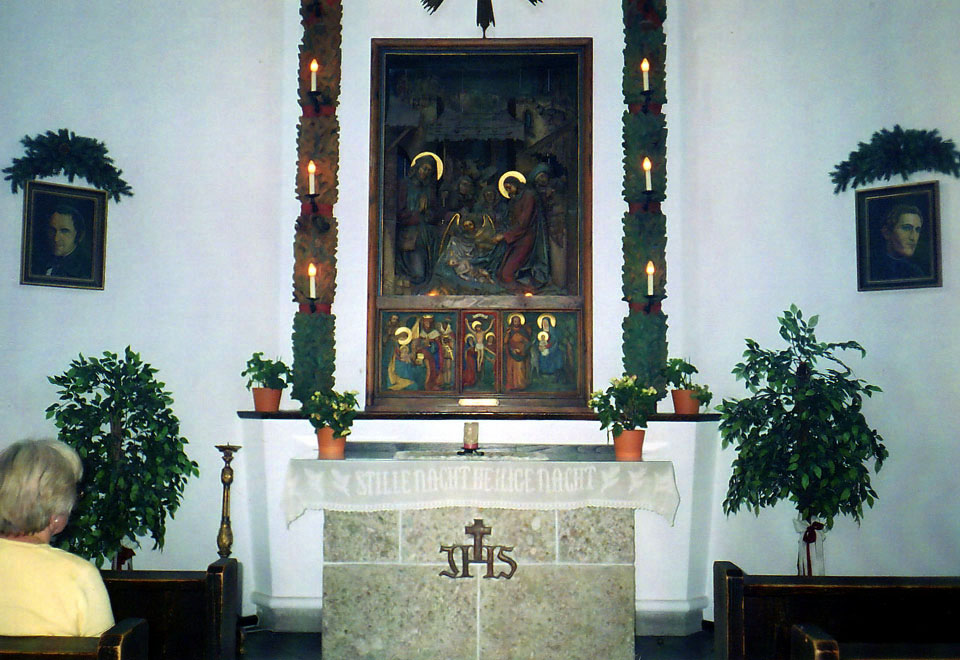 |
|
A Christmas celebration at our new home in Cleveland. The children of the German Language School foster old
tradition from our “Heimat” by presenting a“Grippenspiel”,
a re-enactment of the birth of Christ. |
The “Stille Nacht Kapelle” in Oberndorf, Salzburg,
Austria.
Picture courtesy of:
COSY- Verlag,
A-5020 Salzburg,
Münchner
Bundestrasse 157, Austria. |
The “Stille Nacht Kapelle” in Oberndorf, Salzburg,
Austria where the most famous song in the world was born
and played for the first time by Franz Gruber. It
was composed by Josef Moore on the way home from a sick
visit in the mountains during a light snow when the
church organ broke down. This chapel was erected in its
place to commemorate the location of the church after it
burned down. |
|

|